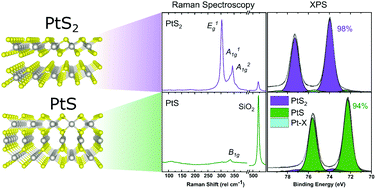Synthesis and characterisation of thin-film platinum disulfide and platinum sulfide†
Abstract
Group-10 transition metal dichalcogenides (TMDs) are rising in prominence within the highly innovative field of 2D materials. While PtS2 has been investigated for potential electronic applications, due to its high charge-carrier mobility and strongly layer-dependent bandgap, it has proven to be one of the more difficult TMDs to synthesise. In contrast to most TMDs, Pt has a significantly more stable monosulfide, the non-layered PtS. The existence of two stable platinum sulfides, sometimes within the same sample, has resulted in much confusion between the materials in the literature. Neither of these Pt sulfides have been thoroughly characterised as-of-yet. Here we utilise time-efficient, scalable methods to synthesise high-quality thin films of both Pt sulfides on a variety of substrates. The competing nature of the sulfides and limited thermal stability of these materials is demonstrated. We report peak-fitted X-ray photoelectron spectra, and Raman spectra using a variety of laser wavelengths, for both materials. This systematic characterisation provides a guide to differentiate between the sulfides using relatively simple methods which is essential to enable future work on these interesting materials.



 Please wait while we load your content...
Please wait while we load your content...